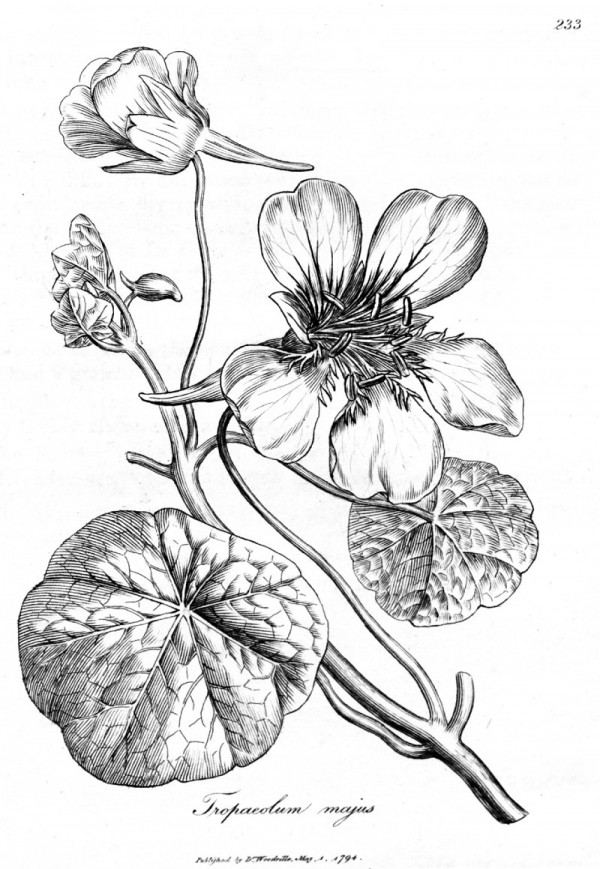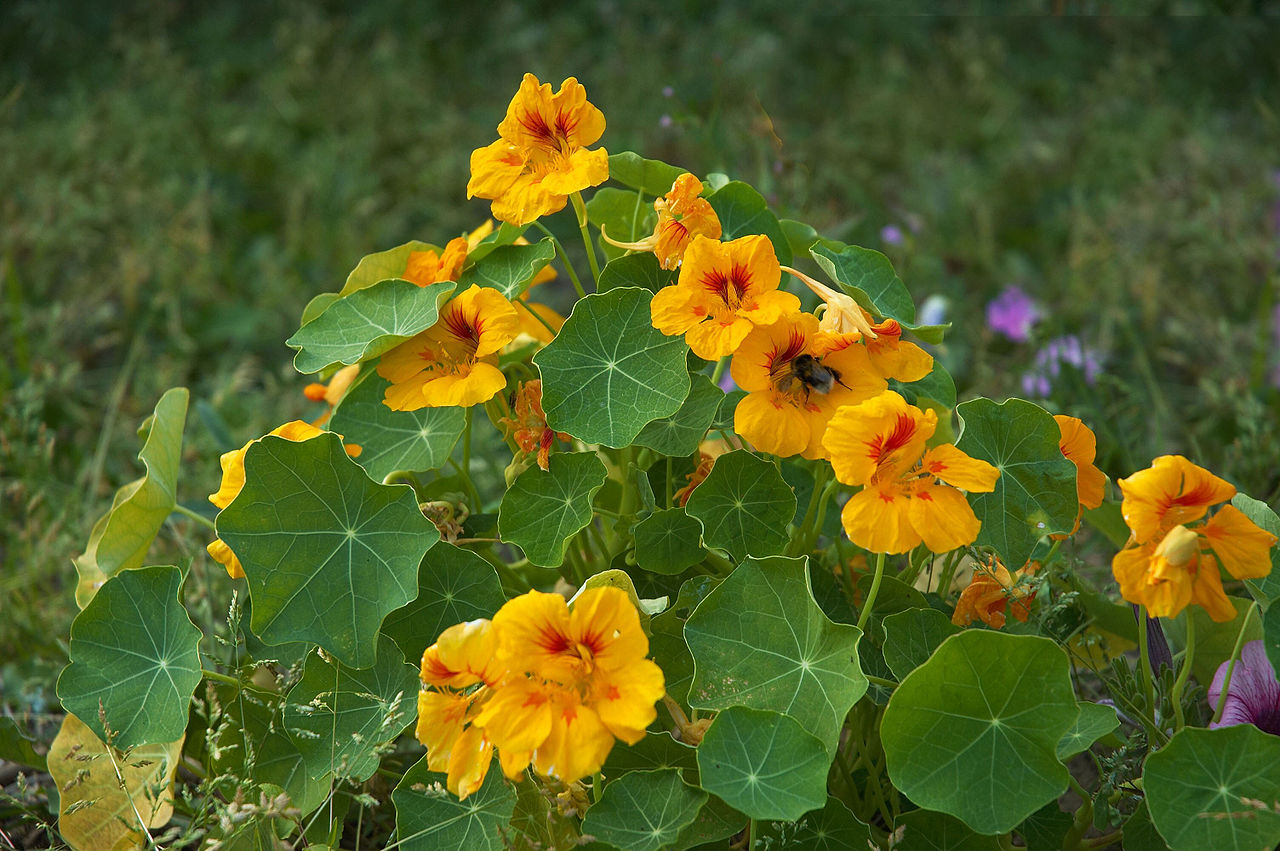Tropaeolum majus L. - Tropaeolaceae - Indian cress, (garden) nasturtium, (Große) Kapuzinerkresse
Annual (tropic perennial) herb, creeping and climbing, only known cultivated, probable hybrid origin tropical South America, naturalized and cultivated elsewhere; leaves orbicular; flowers orange to red.
„It is widely cultivated, both as an ornamental plant and as a medicinal plant… All its parts are edible. The flower has most often been consumed, making for an especially ornamental salad ingredient; it has a slightly peppery taste reminiscent of watercress, and is also used in stir fry. The flowers contain about 130 mg vitamin C per 100 grams (3.5 oz), about the same amount as is contained in parsley. Moreover, they contain up to 45 mg of lutein per 100 gr, which is the highest amount found in any edible plant.“
http://en.wikipedia.org/wiki/Tropaeolum_majus
By headspace examination of the salt-saturated juice from raw vegetable tissue, 2-isopropyl-3-methoxypyrazine, 2-isobutyl-3-methoxypyrazine, and 2-sec-butyl-3-methoxypyrazine have been found important olfactory (green earthy vegetable-like) volatile components of fresh nasturtium plants.
[Murray, Keith E., and Frank B. Whitfield. „The occurrence of 3‐alkyl‐2‐methoxypyrazines in raw vegetables.“ Journal of the Science of Food and Agriculture 26.7 (1975): 973-986]
„Benzylglucosinolate accumulates in mature plants of Tropaeolum majus L. The biosynthetic capacity for synthesis of benzylglucosinolate and the total content of benzylglucosinolate have been investigated during plant development and in different tissues. The content increased from 5 mg of benzylglucosinolate in the fresh seed to between 200 and 400 mg in the adult plant, depending on size. The biosynthetic capacity was measured using L-[U-14C]phenylalanine as precursor. Incorporation levels of approximately 30% were obtained with green leaves, whereas the incorporation levels obtained with other tissues were in the range of 0 to 5%. Leaves were the primary site of benzylglucosinolate synthesis. The high amounts of benzylglucosinolate accumulated in other tissues (e.g. developing seeds) reflected transport of benzylglucosinolate from the leaves… The content of benzylglucosinolate in T.majus flowers increased rapidly during the process of flowering, decreased during flower withering, and increased again during seed formation. “
[Synthesis of benzylglucosinolate in Tropaeolum majus L.(isothiocyanates as potent enzyme inhibitors)., Lykkesfeldt, J., Moller, B.L., Plant Physiology, Vol.102(2), 1993, 609-613]
http://www.plantphysiol.org/content/102/2/609.full.pdf
„Tropaeolum is used as a natural antibiotic to treat infections of the urinary tract and respiratory tract. It is applied topically against various fungal infecions,including candida and as a counter-irritant in case of muscle pain.“
[Medicinal Plants of the World. Ben-Erik Van Wyk and Michael Wink, Pretoria 2004, 326]
The application of nasturtium as a possible way out of antibiotic overuse in industrial breeding of pigs: „Nasturtium (Tropaeolum majus L.) is a herb with a proven antimicrobial activity, which is caused by benzyl-isothiocyanate the degradation product of glucotropaeolin. In an experiment with piglets, direct and graded supplementation of T. majus with the feed was performed over a period of five weeks. T. majus was supplemented at an upper dosage of 1 g/kg with the feed, equaling 48.7 mg/kg glucotropaeolin, which resulted in a benzyl-isothiocyanate concentration in the urine of up to 16 μmol/L, which ought to be high enough to control a broad range of bacteria. Up to 7.3 % of the glucotropaeolin taken up by the animals was excreted as bioactive benzyl-isothiocyanate. Supplementation with T. majus had no effect on growth performance of piglets.“
[Influence of Tropaeolum majus supplements on growth and antimicrobial capacity of glucotropaeolin in piglets., Bloem, E., Berk, A., Haneklaus, S., Selmar, D., Schnug, E., Landbauforschung Volkenrode, Vol.58(3), 2008, 203-210]
http://citeseerx.ist.psu.edu/viewdoc/download?doi=10.1.1.322.3915&rep=rep1&type=pdf#page=63
„Leaves of Tropaeolum majus L. contain high amounts of the glucosinolate glucotropaeolin. They are used in traditional medicine to treat infections of the urinary tract. When Tropaeolum leaves are consumed, glucotropaeolin is hydrolyzed to yield mustard oils, which are absorbed in the intestine and excreted in the urine, exhibiting their antimicrobial activity… In extensive screenings, the dominant parameters determining the glucotropaeolin content in the dried leaves were quantified. It turned out that the glucotropaeolin concentration in the dried leaves represented the most suitable screening parameter. The screening of several hundred Tropaeolum plants resulted in the selection of eight high-yield varieties, from which in vitro plants had been generated and propagated as a source for large field trials.“
[The Glucosinolate-Myrosinase System in Nasturtium (Tropaeolum majus L.): Variability of Biochemical Parameters and Screening for Clones Feasible for Pharmaceutical Utilization., Kleinwächter, M., Schnug, E., Selmar, D., Journal of agricultural and food chemistry, Vol.56(23), 2008, 11165-11170]
„Indian cress (Tropaeolum majus L.) has been consumed in salad or soup for decades… we report on the study of the odorant profile and odor-impact compounds of Indian cress absolute… Forty-four odorant compounds were identified among which 22 (50% of the identified odorant molecules) were identified… These trace compounds were not detected by 1D-qMS or could only be found with specific searches once they were detected by comprehensive 2D-GC, although they were well perceived by the judges in GC-O. This was amongst others the case for the two molecules having the highest odor impact, (E)-hex-2-enal (fruity) and diethyl trisulfide (alliaceous, sulfury, cabbage). A powerful sulfur-containing odor compound whose first identification in cress was recently reported by the authors was detected by GC-O: O,S-diethyl thiocarbonate (fruity/red fruit and sulfury odor).“
[Characterization of volatile compounds of Indian cress absolute by GC-olfactometry/VIDEO-sniff and comprehensive two-dimensional gas chromatography., Breme, K., Tournayre, P., Fernandez, X., Meierhenrich, U. J., Brevard, H., Joulain, D., Berdague, J.L., Journal of agricultural and food chemistry, Vol.58(1), 2009, 473-480]
Benzyl-isothiocyanate and 2-phenylethyl-isothiocyanate were the most effective compounds among the purified isothiocyanates tested against 15 isolates of methicillin-resistant S. aureus isolated from diabetic foot-ulcer patients.
[Antimicrobial Activity of Isothiocyanates from Cruciferous Plants against Methicillin-Resistant Staphylococcus aureus (MRSA)., Dias, C., Aires, A., Saavedra, M.J., International journal of molecular sciences, 15(11), 2014, 19552-19561] http://www.mdpi.com/1422-0067/15/11/19552/htm

Woodville, W., Medical botany, vol.4, t.233 (1794)
http://plantgenera.org/species.php?id_species=1038247

Tropaeolum majus
Wouter Hagens (2006), wikimedia commons, © Public Domain
